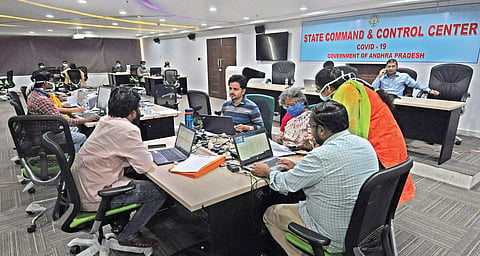

VIJAYAWADA: It was around 3 pm on Thursday when a notification popped up on the computer screen of a member of the integrated disease surveillance programme (IDSP) team, which is monitoring Covid-19 pandemic in the state.
The notification was about the test results of a few Covid-19 suspects with a travel history to New Delhi.
Immediately, the IDSP passed on the information to the officials at one of the 15 tables arranged on the fifth floor of the R and B Building on MG Road, Vijayawada.
From there, the information was forwarded to the authorities in East Godavari, who in turn ensured the data flow to field functionaries—village volunteers and ASHA workers—for verification and necessary action. All this was done in minutes.
Welcome to the state command control centre, the war room from where Andhra Pradesh is putting up a concerted fight against the novel coronavirus. “All the surveillance and contact tracing happens from here.
The IDSP team is the heart of the command control centre. It is the point of contact for all inter-state and inter-district communication related to Covid-19.
The four-member IDSP team gets all the data related to the state from the National Centre for Disease Control (NCDC), apart from the test results from laboratories,” O Anand, the special officer in-charge of the control room, told TNIE.
There are a total of 16 teams working to flatten the covid-19 curve: one each for 13 districts, the IDSP team, a management information system (MIS) and an inter-departmental team.
The district teams coordinate with the respective administrations to take and feed necessary statistics as and when required.
The inter-departmental team consists of officials from the Railways, APSRTC, Transport and Telecom departments to assist the district teams in ascertaining the travel history of the suspected patients; the MIS team does the data crunching.
Around 120 officials, most of whom are from the Health department, have been working round-the-clock for the last three weeks.
“We don’t even get to go home sometimes. We feel homesick, but this is an emergency and the state comes before everything else. That was the commitment we made when we took this job,” an official of the East Godavari team said.
While data analysis is in itself tough, especially when it involves information related to over one lakh people (30,000 foreign returnees, and over 1,000 Delhi returnees and their primary contacts), officials, however, said contact tracing was the most challenging part of the job.
“Primary and secondary contact tracing has to be done as soon as possible. Sometimes, the suspects don’t reveal their entire travel history. That is when it gets difficult,” Anand explained.
On an average, it takes at least a day or two to collect and verify the travel history of the suspects and positive cases.
In cases where the officials are suspicious about the details given by a suspect, they use the mobile data (signal reception) to crosscheck the information they were provided. “It is not surveillance, but only a precautionary measure.
As challenging as it is for us to get the data, it is the efforts of our field functionaries and district administrations as it is they who do most of the legwork,” the special officer observed.
Once the control room and the district administration are on the same page regarding the details of the suspects/positive cases, they immediately pass it on to the state nodal officer, sitting one floor below the command control room.
“After compiling the information, we release the data for the government, media and the public,” said state nodal officer Dr Arja Srikanth.
Besides giving statistics related to the number of patients and suspects, the control room was also conducting awareness programmes, he added.
“The most important thing to do is to create awareness and dispel misinformation. Misleading information can do more damage than a disease.”
How the control room operates
It takes at least a day or two to collect and verify the travel history of the suspects and positive cases
In cases where the officials are suspicious about the details given by a suspect, they use mobile data (signal reception) to crosscheck the information
16 teams working to flatten the covid-19 curve at the command control room. One team assigned to each district
The IDSP team, the “heart” of the command control centre, coordinate with the National Centre for Disease Control regarding data related to the state
District teams coordinate with respective administrations for input and output of data; MIS team does the data crunching